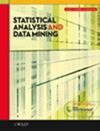A Machine-Learning Approach to Detecting Unknown Bacterial Serovars.
IF 2.1
4区 数学
Q3 COMPUTER SCIENCE, ARTIFICIAL INTELLIGENCE
引用次数: 19
Abstract
Technologies for rapid detection of bacterial pathogens are crucial for securing the food supply. A light‐scattering sensor recently developed for real‐time identification of multiple colonies has shown great promise for distinguishing bacteria cultures. The classification approach currently used with this system relies on supervised learning. For accurate classification of bacterial pathogens, the training library should be exhaustive, i.e., should consist of samples of all possible pathogens. Yet, the sheer number of existing bacterial serovars and more importantly the effect of their high mutation rate would not allow for a practical and manageable training. In this study, we propose a Bayesian approach to learning with a nonexhaustive training dataset for automated detection of unknown bacterial serovars, i.e., serovars for which no samples exist in the training library. The main contribution of our work is the Wishart conjugate priors defined over class distributions. This allows us to employ the prior information obtained from known classes to make inferences about unknown classes as well. By this means, we identify new classes of informational value and dynamically update the training dataset with these classes to make it increasingly more representative of the sample population. This results in a classifier with improved predictive performance for future samples. We evaluated our approach on a 28‐class bacteria dataset and also on the benchmark 26‐class letter recognition dataset for further validation. The proposed approach is compared against state‐of‐the‐art involving density‐based approaches and support vector domain description, as well as a recently introduced Bayesian approach based on simulated classes. Copyright © 2010 Wiley Periodicals, Inc. Statistical Analysis and Data Mining 3: 289‐301, 2010



检测未知细菌血清型的机器学习方法。
快速检测细菌病原体的技术对于确保粮食供应至关重要。最近开发的一种用于实时识别多个菌落的光散射传感器在区分细菌培养方面显示出很大的希望。该系统目前使用的分类方法依赖于监督学习。为了准确地分类细菌病原体,训练库应该是详尽的,也就是说,应该包括所有可能的病原体的样本。然而,现有细菌血清型的绝对数量,更重要的是它们的高突变率的影响,不允许进行实际和可管理的训练。在这项研究中,我们提出了一种贝叶斯方法来学习非穷举训练数据集,用于自动检测不匹配的细菌血清型,即训练库中没有样本的血清型。我们工作的主要贡献是定义在类分布上的Wishart共轭先验。这允许我们使用从已知类中获得的先验信息来对未知类进行推断。通过这种方法,我们可以识别新的具有信息价值的类别,并使用这些类别动态更新训练数据集,使其越来越具有样本总体的代表性。这导致分类器对未来样本的预测性能有所提高。我们在28类细菌数据集和基准26类字母识别数据集上评估了我们的方法,以进一步验证。将提出的方法与基于密度的方法和支持向量域描述的最新方法以及最近引入的基于模拟类的贝叶斯方法进行了比较。
本文章由计算机程序翻译,如有差异,请以英文原文为准。
求助全文
约1分钟内获得全文
求助全文
来源期刊

Statistical Analysis and Data Mining
COMPUTER SCIENCE, ARTIFICIAL INTELLIGENCEC-COMPUTER SCIENCE, INTERDISCIPLINARY APPLICATIONS
CiteScore
3.20
自引率
7.70%
发文量
43
期刊介绍:
Statistical Analysis and Data Mining addresses the broad area of data analysis, including statistical approaches, machine learning, data mining, and applications. Topics include statistical and computational approaches for analyzing massive and complex datasets, novel statistical and/or machine learning methods and theory, and state-of-the-art applications with high impact. Of special interest are articles that describe innovative analytical techniques, and discuss their application to real problems, in such a way that they are accessible and beneficial to domain experts across science, engineering, and commerce.
The focus of the journal is on papers which satisfy one or more of the following criteria:
Solve data analysis problems associated with massive, complex datasets
Develop innovative statistical approaches, machine learning algorithms, or methods integrating ideas across disciplines, e.g., statistics, computer science, electrical engineering, operation research.
Formulate and solve high-impact real-world problems which challenge existing paradigms via new statistical and/or computational models
Provide survey to prominent research topics.
 求助内容:
求助内容: 应助结果提醒方式:
应助结果提醒方式:


